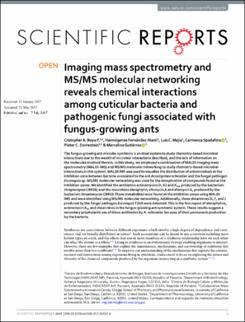Imaging mass spectrometry and MS/MS molecular networking reveals chemical interactions among cuticular bacteria and pathogenic fungi associated with fungus-growing ants
Date
2017-07-17Author
Boya P, Cristopher A.
Fernández-Marín, Hermógenes
Mejía, Luis C.
Spadafora, Carmenza
Dorrestein, Pieter C.
Gutiérrez, Marcelino
Metadata
Show full item recordAbstract
The fungus-growing ant-microbe symbiosis is an ideal system to study chemistry-based microbial interactions due to the wealth of microbial interactions described, and the lack of information on the molecules involved therein. In this study, we employed a combination of MALDI imaging mass spectrometry (MALDI-IMS) and MS/MS molecular networking to study chemistry-based microbial interactions in this system. MALDI IMS was used to visualize the distribution of antimicrobials at the inhibition zone between bacteria associated to the ant Acromyrmex echinatior and the fungal pathogen Escovopsis sp. MS/MS molecular networking was used for the dereplication of compounds found at the inhibition zones. We identified the antibiotics actinomycins D, X2 and X0β, produced by the bacterium Streptomyces CBR38; and the macrolides elaiophylin, efomycin A and efomycin G, produced by the bacterium Streptomyces CBR53.These metabolites were found at the inhibition zones using MALDI IMS and were identified using MS/MS molecular networking. Additionally, three shearinines D, F, and J produced by the fungal pathogen Escovopsis TZ49 were detected. This is the first report of elaiophylins, actinomycin X0β and shearinines in the fungus-growing ant symbiotic system. These results suggest a secondary prophylactic use of these antibiotics by A. echinatior because of their permanent production by the bacteria.

